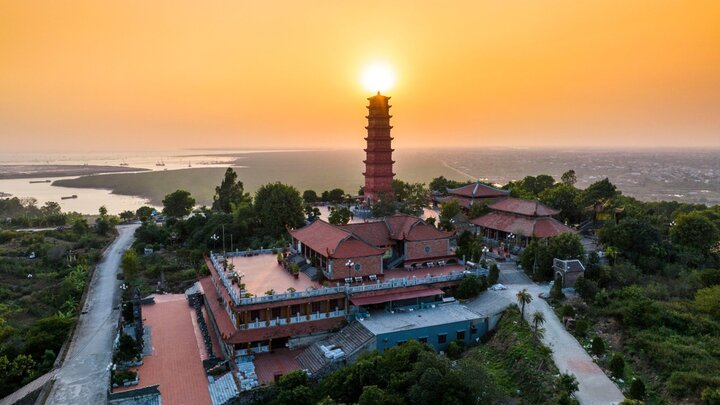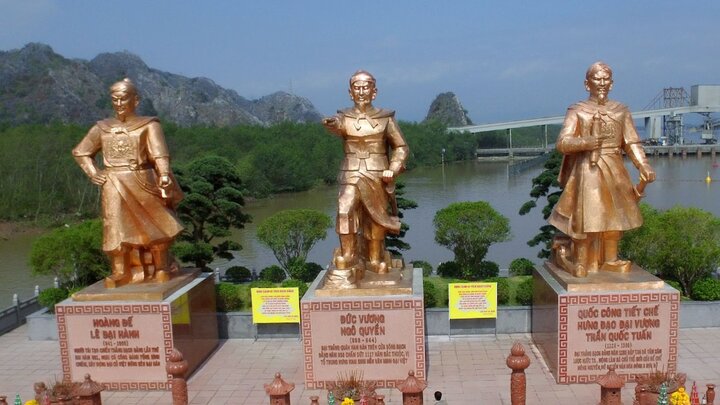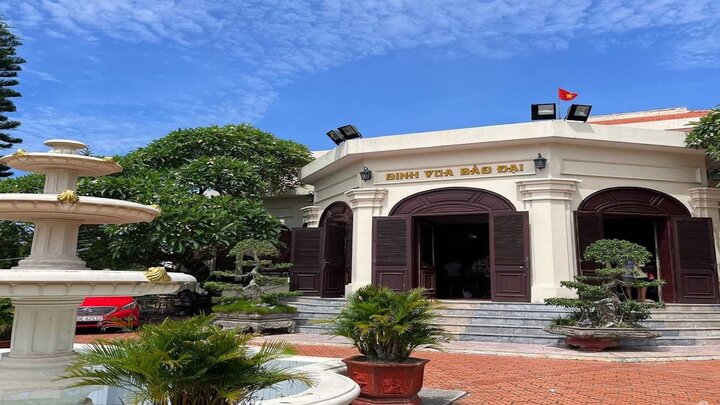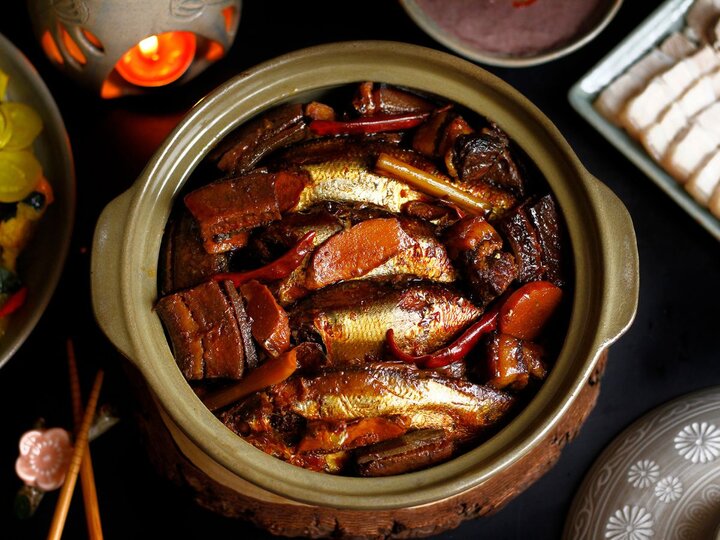1. Overview of Historical Sites in Hai Phong
Over many centuries, Hai Phong has always held an important position in defending the northern gateway of the Fatherland. This port city was once the site of three resounding victories on the Bach Dang River, is the homeland of many famous figures such as Nguyen Binh Khiem, and was also the center of power for the Mac Dynasty.

Remains at Ben K15. (Source: Collected)
With its advantageous location in the Northern coastal plains, Hai Phong has become a convergence of many different cultural aspects. The development of the port city over the past century has contributed to affirming its status as a typical cultural and economic center of the North. Thanks to this, Hai Phong not only possesses the modern, dynamic appearance of a port city but also preserves unique traditional values, creating an inimitable identity.
Hai Phong city currently has 3,981 relics, including 02 world heritage sites, 09 special national relics, 257 national relics, 722 city-level relics, and 33 national treasures. Notable among them are Cat Ba Archipelago, Con Son – Kiep Bac, Bach Dang Giang, and the City Theater. Additionally, Hai Phong boasts 02 intangible cultural heritages recognized by UNESCO: Belief in the Mother Goddesses of the Three Palaces and Ca Tru singing, along with 24 national intangible cultural heritages and 1,289 festivals. This rich heritage system is contributing to making Hai Phong an attractive cultural and historical tourist destination in the North.
These figures affirm Hai Phong's role on Vietnam's cultural heritage map. Traditional festivals such as the Tu Luong Xam Festival, the Nghe Temple Festival, or the Bach Dang Giang Festival not only preserve historical values but also provide opportunities for visitors to immerse themselves in the vibrant cultural flow of this land.
2. Top 10 Outstanding Historical Sites in Hai Phong 2026
2.1. Tu Luong Xam Relic Complex
The historical sites in Hai Phong complex of Tu Luong Xam is a site associated with a momentous event in national history. This was where Ngo Quyen established his headquarters to prepare for the battle on the Bach Dang River in 938, ushering in an era of self-rule for the country after centuries of foreign domination.
After Ngo Quyen's death, the local people built a temple to commemorate his great contributions. Throughout the dynasties, this place was continuously honored to celebrate the achievements of the national hero. The current relic site includes the main temple, a memorial house, and an exhibition space for valuable historical artifacts.
The traditional Tu Luong Xam festival, held annually in the second lunar month, was recognized as a national intangible cultural heritage in 2022. The festival atmosphere is lively with solemn palanquin processions, ceremonies, and many unique folk entertainment activities such as Quan Ho singing and water puppetry.

Entrance at the Luong Xam relic cluster. (Source: Collected)
2.2. K15 Numberless Boat Pier
K15 Pier, located in Van Son ward, Do Son district, despite its simple name, holds extremely special historical value. This pier was the starting point for the Numberless Boat Fleet during the anti-American war period, a place for receiving and transporting weapons and soldiers from the North to the South.
Upon arrival, visitors can witness the remaining relics of the old pier, wooden posts from the war era, and a memorial tablet commemorating the contributions of the sea soldiers. The tranquil atmosphere by the Do Son coast creates a solemn feeling, reminding us of the courageous spirit of the people from the port city.

Tourists check-in at Pier K15. (Source: Lam Dong Newspaper)
2.3. Mac Dynasty Historical Site Complex in Duong Kinh
The area in Ngu Doan commune, Kien Thuy district, was once the political center of the Mac Dynasty in the 16th century. This Hai Phong historical site complex includes many components such as Kinh Thien Palace, statues of Mac kings, and a system of stone steles recording important events of this period.
The ancient wooden architecture and well-preserved palace foundations create a solemn space. There is also an archaeological exhibition area, helping visitors understand more about court life as well as cultural achievements under the Mac Dynasty. Not only that, many valuable national treasures such as stone steles and bronze bells are also preserved in this complex.
The annual ceremony commemorating the Mac kings is held with solemnity, imbued with national cultural identity. In the sacred atmosphere, traditional rituals such as incense offering, lễ tế (worship ceremony), and procession are meticulously performed, showing deep gratitude for the nation-building contributions of the Mac Dynasty. This event not only attracts a large number of local people but also fascinates tourists from all over to visit, learn about history, and immerse themselves in the unique cultural space of Hai Phong.
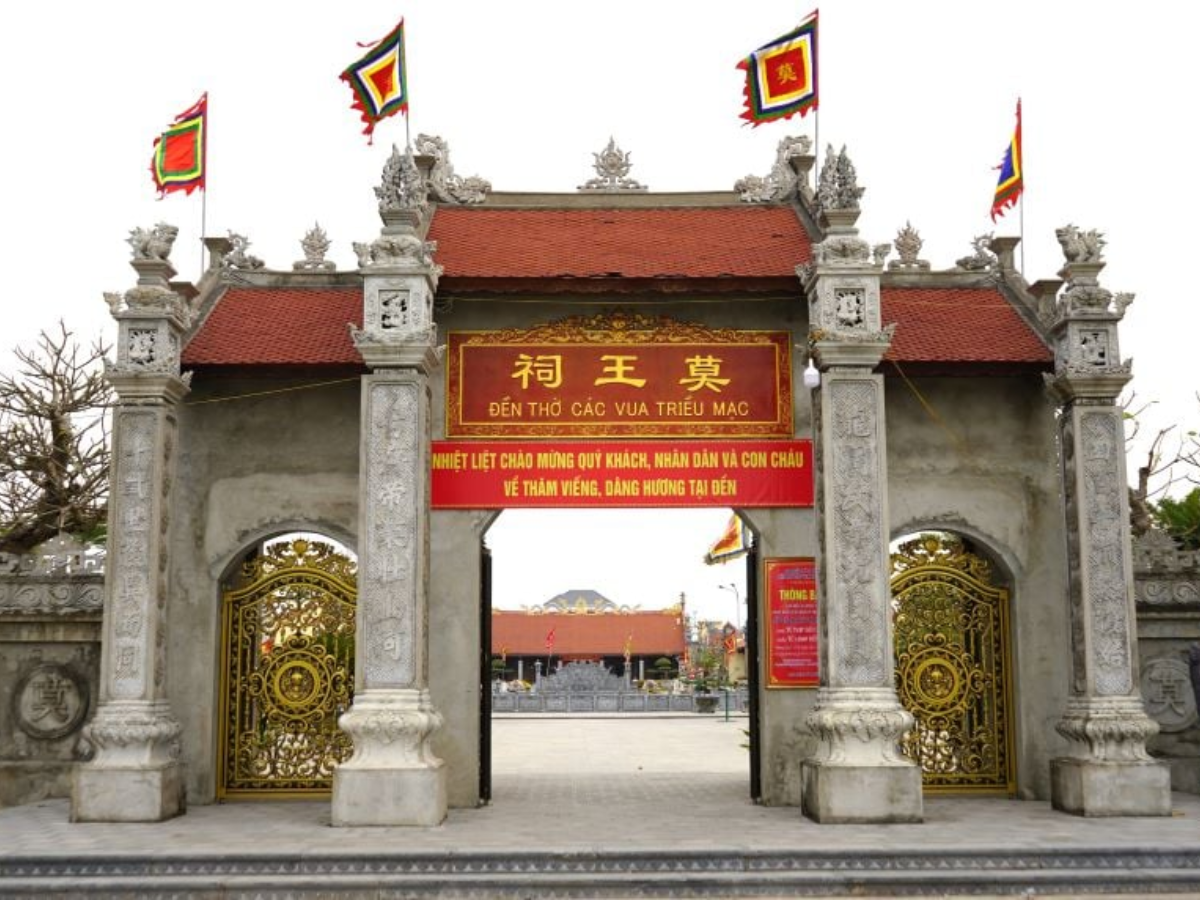
Entrance to the Mac dynasty historical site in Duong Kinh. (Source: Collected)
2.4. . Kien Bai Communal House
Kien Bai Communal House is located in Kien Bai Commune, Kien Thanh Commune, Hai Phong, worshipping two Chinese deities, Cam Ung Thuong Dang Than and Loi Cong Uy Dieu Thuong Dang Than, who are believed to have helped King Tran defeat the Yuan invaders and brought peace and prosperity to the people of Kien village. The communal house bears the distinct architectural style of the Le Dynasty, with a "Dinh" (丁) shaped structure, featuring intricate carvings of dragons, phoenixes, floral motifs, and vivid scenes of folk life.
Annually, from the 10th to the 13th day of the first lunar month, the communal house hosts the Kien village festival with many traditional games such as singing duels, chung cake making, and "cuop cay bong" (a game involving a decorated pole). The winners are considered blessed by the deities and receive the villagers' veneration. Notably, if the winners of two competitions are unmarried males and females, the villagers often bless them and encourage them to form a union – a distinctive cultural beauty of the Kien Bai region.
2.5. Temple of Nguyen Binh Khiem
The Temple of Trạng Trình Nguyen Binh Khiem is a place to commemorate one of the most outstanding cultural figures of this land. Nguyen Binh Khiem was renowned not only for his literary talent but also as a wise philosopher and forecaster.
The relic site is vast, featuring a statue of Trạng Trình, a memorial house displaying his literary works, and his tomb. The "Bach Van Am" garden, where he lived and composed, still retains its former peace and tranquility.
Anniversaries commemorating Nguyen Binh Khiem's birthday (10th day of the 4th lunar month) and death anniversary (28th day of the 11th lunar month) often attract a large number of tourists and locals to pay their respects, demonstrating deep admiration for this national hero.

The Nguyen Binh Khiem Temple is splendid with its striking yellow design. (Source: Collected)
2.6. Bach Dang Giang Historical Site
Minh Duc Commune, Thuy Nguyen District is the location where three great historical victories took place on the Bach Dang River. This is a Haiphong historical site associated with important battles in the years 938, 981, and 1288, under the leadership of talented generals such as Ngo Quyen, Le Dai Hanh, and Tran Hung Dao.
This area is highlighted by large statues and many temples dedicated to national heroes, creating a sacred space. In particular, the exhibition area of wooden stakes from the Bach Dang River, excavated from the riverbed, remains intact, serving as vivid proof of the Vietnamese nation's ingenious military art.
The vast space along the Bach Dang River offers visitors an experience of both exploration and admiration of the magnificent natural scenery. The river gently winds through the historical land, combined with the fresh air and the immense river landscape, creating a peaceful yet majestic picture. This is an ideal destination for tourists to relax, sightsee, and feel the poetic beauty of the land associated with glorious victories in the nation's history.
2.7. Nghe Temple
Nghe Temple is a special Haiphong historical site located right in the city center. It is dedicated to the female general Le Chan, who pioneered and defended this land from invaders. The temple is not only a sacred spiritual destination but also a cultural symbol, marking the gratitude and pride of the people of Haiphong towards the proud female hero of their homeland.
The temple's architecture is notable for its intricately carved stone columns, numerous precious statues, and ancient stone steles, all contributing to a solemn atmosphere. The vivid worship paintings depicting the female general in battle attire have left a strong impression on visitors.
The Nghe Temple festival takes place in the 2nd, 8th, and 12th lunar months with many activities such as palanquin processions and folk games, bringing a traditional festival atmosphere rich in local color. This event is not only an occasion for people to remember the merits of General Le Chan but also an opportunity for tourists to immerse themselves in the unique cultural space, feeling the spirit of solidarity and pride of the people of the Port City.
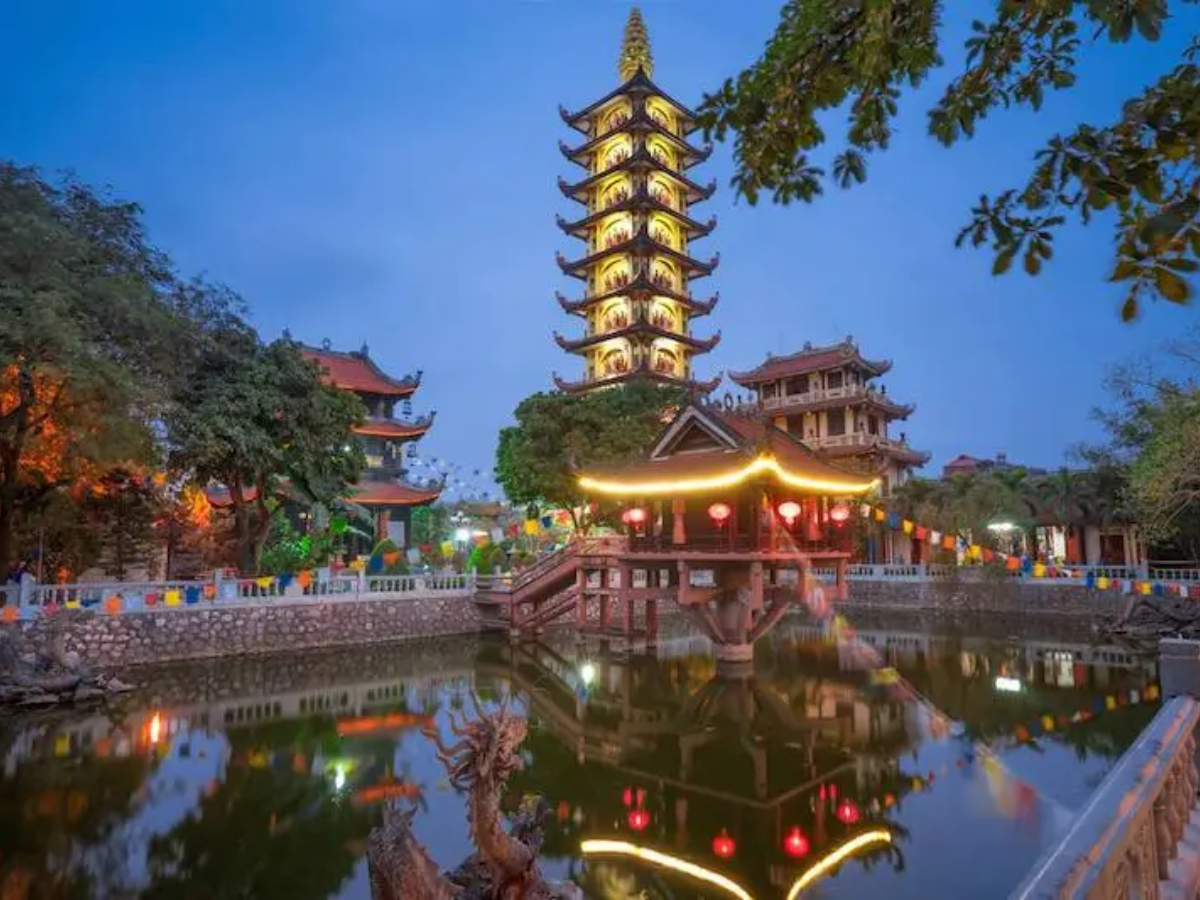
Nghe Temple shimmering at night. (Source: Collected)
2.8. Du Hang Pagoda
Du Hang Pagoda, originally named Phuc Lam Tu, is one of the oldest pagodas. Built during the Tien Le period and later renovated under the Ly dynasty, this Haiphong historical site still preserves many ancient artistic and architectural values.
Buddhist statues, bronze bells, and stone steles from the 17th-18th centuries are carefully preserved, showcasing the skill of ancient artisans. Amidst the vibrant city life, the pagoda is an ideal place to find a quiet, peaceful space and experience the beauty of Buddhist culture.
Not only valuable for its architecture, Du Hang Pagoda is also an important center for Buddhist activities, respected by the city's residents who frequently visit to pray for peace.
2.9. Thu Ngư Fortress (Cat Ba)
Thu Ngư Fortress is located on the southern peak of Cat Ba Island, a strategically important point for defending maritime sovereignty. This Haiphong historical site once housed defensive military installations during the periods of resistance against the French and Americans.

Statue of Thu Ngu Fortress in Cat Ba. (Source: Collected)
The system of underground tunnels, artillery positions, and military structures are still preserved intact, providing a clear sense of the island and sea defense tactics of our army and people. Standing at the fortress, visitors can cast their eyes over the panoramic view of Lan Ha Bay with countless limestone islands and clear blue sea.
The fortress's special location holds both historical significance and serves as a beautiful viewpoint, creating an exploration experience that harmoniously blends the past and the present. To travel to the island conveniently, visitors can choose the Sun World Cat Ba cable car route. This modern mode of transport shortens travel time and saves costs compared to traditional ferries, while also offering an impressive experience of viewing the sea from above.

3-wire cable car line at Sun World Cat Ba.
2.10. Kim Son Communal House and Phu Xa Temple
These two historical sites of Hai Phong represent the ancient communal house architectural art and the typical worship beliefs of coastal residents.
Kim Son Communal House in Tan Trao commune, Kien Thuy district is associated with the anti-Japanese movement and is where Nam Hai Dai Vuong is worshipped, the deity protecting the coastal people. The work has ancient architecture with many exquisite carved details, reflecting the skill of ancient artisans.
Phu Xa Temple in Dong Hai 1 ward, Hai An district worships human deities who contributed to reclaiming land and protecting the coastal area from natural disasters. Both sites hold traditional festivals on the 8th and 20th of the second and eighth lunar months, creating a joyful atmosphere and fostering community cohesion among locals and visitors from all directions.
3. Guide to Visiting Hai Phong Historical Sites in 2026
3.1. Suggested 2-Day 1-Night Itinerary for Experiencing Hai Phong Historical Sites
In the morning, visitors begin their journey at the Bach Dang Giang Historical Site, which preserves the imprints of three glorious naval battles in national history. Afterwards, visit the Temple of Scholar Trang Trinh Nguyen Binh Khiem in Vinh Bao, admire the ancient space and listen to anecdotes about the world-renowned cultural figure.
In the afternoon, return to the city center to visit Du Hang Pagoda, a pagoda over 400 years old, then stroll around Hai Phong Opera House and the Love Lock Bridge by the Tam Bac River. Conclude the day of sightseeing by enjoying local cuisine such as banh da cua (crab noodle soup) and nem cua be (crab spring rolls) in the bustling seaside atmosphere.
3.2. Experience and Notes for Visiting Hai Phong Historical Sites
During your visit to Hai Phong historical sites, choosing modest and polite attire is essential, especially in temple and pagoda areas, which are sacred spaces. Please speak softly, behave civilly, and comply with traditional regulations and rituals to show respect for the local culture.
When taking souvenir photos, you should limit taking pictures in the worship areas, avoid using flash with ancient artifacts, and follow the specific instructions at each site. Travel between locations can be done using personal vehicles, taxis, or by joining group tours for more convenience.
To capture impressive photos, you should choose angles with ancient stone pillars, large statues, or traditional communal house gates. Traditional attire will help you blend in with the historical context. If you have the opportunity to participate in festivals such as Nghe festival or Tu Luong Xam festival, you will have many unforgettable cultural experiences.
Proactively planning your trip to coincide with festival dates, and contacting guides in advance to get clear information about festival schedules will make your trip more complete and memorable.
The historical sites of Hai Phong are not only places that preserve cultural and traditional values but also offer visitors many profound experiences in their exploration journey. Each structure, each relic is a symbol of the indomitable spirit and pride of the people of the port city. Let us together preserve and promote, so that the cultural values of Hai Phong continue to spread to future generations.

